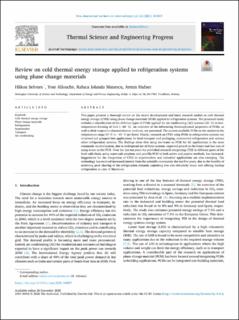| dc.contributor.author | Selvnes, Håkon | |
| dc.contributor.author | Allouche, Yosr | |
| dc.contributor.author | Manescu, Raluca Iolanda | |
| dc.contributor.author | Hafner, Armin | |
| dc.date.accessioned | 2021-09-10T06:37:18Z | |
| dc.date.available | 2021-09-10T06:37:18Z | |
| dc.date.created | 2021-03-17T10:12:06Z | |
| dc.date.issued | 2021 | |
| dc.identifier.citation | Thermal Science and Engineering Progress. 2021, 22 . | en_US |
| dc.identifier.issn | 2451-9049 | |
| dc.identifier.uri | https://hdl.handle.net/11250/2775071 | |
| dc.description.abstract | This paper presents a thorough review on the recent developments and latest research studies on cold thermal energy storage (CTES) using phase change materials (PCM) applied to refrigeration systems. The presented study includes a classification of the different types of PCMs applied for air conditioning (AC) systems (20 °C) to low-temperature freezing of food (−60 °C). An overview of the influencing thermophysical properties of PCMs, as well as their respective characterisation methods, are presented. The current available PCMs on the market in the temperature range 10 °C to −65 °C are listed. Finally, research on CTES using PCMs in refrigeration systems are reviewed and grouped into applications for food transport and packaging, commercial refrigeration and various other refrigeration systems. The findings show that using ice/water as PCM for AC applications is the most commonly studied system, due to widespread use of these systems, expected growth in the future and low cost of using water as the PCM. Over the last ten years the published research integrating CTES in different parts of the food cold chain, using water-salt solutions and paraffin PCM in both active and passive methods, has increased. Suggestions for the integration of CTES in supermarkets and industrial applications are also emerging. The technology has received increased interest from the scientific community the last five years, due to the benefits of achieving peak shaving of the refrigeration demand, exploiting low-cost electricity hours and offering backup refrigeration in case of blackouts. | en_US |
| dc.language.iso | eng | en_US |
| dc.publisher | Elsevier | en_US |
| dc.relation.uri | https://www.sciencedirect.com/science/article/pii/S2451904920303279 | |
| dc.rights | Navngivelse 4.0 Internasjonal | * |
| dc.rights.uri | http://creativecommons.org/licenses/by/4.0/deed.no | * |
| dc.title | Review on cold thermal energy storage applied to refrigeration systems using phase change materials | en_US |
| dc.type | Peer reviewed | en_US |
| dc.type | Journal article | en_US |
| dc.description.version | publishedVersion | en_US |
| dc.source.pagenumber | 26 | en_US |
| dc.source.volume | 22 | en_US |
| dc.source.journal | Thermal Science and Engineering Progress | en_US |
| dc.identifier.doi | https://doi.org/10.1016/j.tsep.2020.100807 | |
| dc.identifier.cristin | 1898562 | |
| dc.relation.project | Norges forskningsråd: 257632 | en_US |
| cristin.ispublished | true | |
| cristin.fulltext | postprint | |
| cristin.qualitycode | 1 | |

